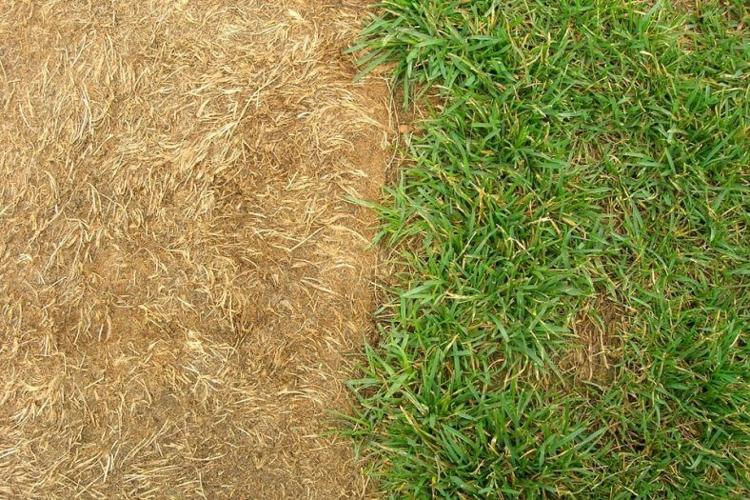Driving around the country side often gives me ideas on what to write about. In this case, fertilizer burn on turf — a lot of turf.
If a little is good a lot is better? Yes, in the case of ice cream … Not in the case of fertilizer.
Fertilizer products already allow for human mistakes or over use by stuffing in “inert” ingredients into dry or liquid fertilizers. So when you purchase a bag of 10-pound bag of 20-0-0, you are getting 20 parts nitrogen and 80 parts inert ingredients. The inert ingredients in dry fertilizer could be ground agricultural waste like corn cob or soy bean husks. Liquid fertilizers would likely have water as a main inert ingredient.
This particular yard is near my home and was sodded about 3 years ago. Now it is a sickly yellow and after this heat streak, it will likely all be dead.
If you also have over fertilized, your best chance of saving your turf is to water, water and water. Any stressed plants — including grass — are also more susceptible to damage by insects and other disease or disorders.
It is also best not to mow the grass when we are in a prolonged heat wave. If you must, mow it high. Longer grass blades will help to create its own shade and reduce water evaporation from the soil.
If fertilizer burn is serious enough to kill your lawn, now what? If you had sodded, then it’s best to rent a sod stripper and pull it up and start over. If your lawn had originally been seeded, it will be harder to remove the turf layer. In this case you may try overseeding the area with grass seed. Leave the dead grass in place and spread seed over it. The dead grass will help to keep the grass seed in place while it germinates.
You could also try this with a sodded area, however sod pieces may shrink up and away from each other creating a lumpy surface. In this case removing is best. Soil areas need to stay moist to allow the seed to germ, but excessive water can wash the seeds away. Wait until after the heat to attempt overseeding — fall is best if you can wait.
Hot summer days
With prolonged hot sunny weather, even established perennials may need a drink of water. A good deep soaking is best once or twice a week. A daily sprinkling on perennials barely helps as the water doesn’t reach the roots. Newly planted flowers or vegetable plants benefit more from frequent/lighter waterings as their roots are closer to the surface.
A couple hours after watering, check your watering result by using a trowel or shovel to dig down a bit and see if the soil is moist under the surface. Any plants in display containers or still in nursery pots need daily watering. If you find a really stressed plant, move it to shade to recover if it’s in a container. If it’s planted in the garden, place a lawn chair or outdoor table over it to create shade so it can recover. If plants are not past “the point of no return,” they will eventually recover. You will have your answer in a day or so!
Leaves on some plants naturally hang downwards during the heat of the day like squash plants, to reduce the surface area to the sun – plants are so smart! Shrubs and trees planted within the past year need help, too. To water them, wet down the area around the tree, then lay the hose at the base, turned on low and set your timer for about 20 minutes. Wetting down the surrounding area helps the water to move to the needed area verses creating a small river and running away from the intended target. Keep cool my friends!
在访问我们位于曼卡多农贸市场the Best Buy parking lot on Adams Street from 8 a.m. to noon Saturdays and 3:30-6 p.m. Tuesdays and Thursdays. Follow my Facebook business page at Market Bakery.
To respect everyone’s health, and ensure that the market can stay open, please stay home if you’re sick, send one healthy family member to shop, wash your hands often (stations will be set up), no onsite consumption of food and shop with your eyes — vendors will handle items.




































Commented
Sorry, there are no recent results for popular commented articles.